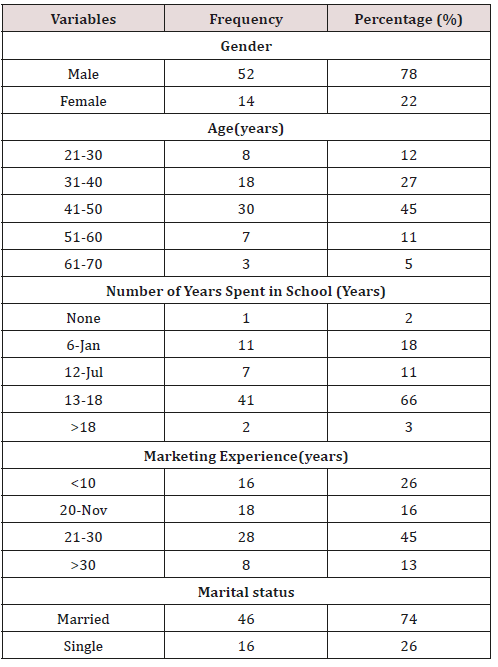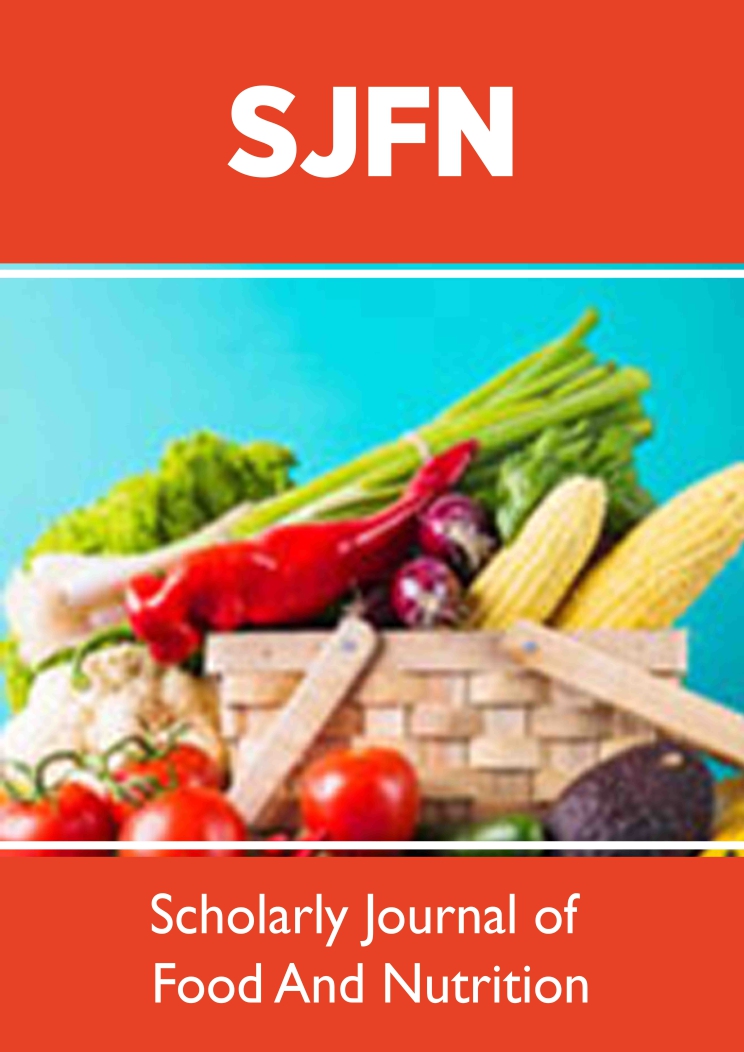
Lupine Publishers Group
Lupine Publishers
Menu
ISSN: 2638-6070
Research Article(ISSN: 2638-6070) 
Net Revenue Determination of Beans Marketers in Imo State, Nigeria
Volume 2 - Issue 1Osuji MN*
- Department of Agricultural Economics, Federal University of Technology, Nigeria
Received: July 09, 2019; Published: July 24, 2019
*Corresponding author: Osuji MN, Department of Agricultural Economics, Federal University of Technology, Nigeria
DOI: 10.32474/SJFN.2019.02.000131
Abstract
The study is on net revenue determination of beans marketers in Imo state, Nigeria. Specifically, it examines the socioeconomic characteristics of the respondents, determines the factors influencing the selling price and marketing margin of beans and identifies the marketing constraint for beans in the study area. Purposive and simple random sampling techniques were employed to select eighteen (18) wholesalers and forty-eight (48) retailers. Descriptive statistics and multiple regression models were used to analyze the data collected. Results showed that majority of the beans traders were males, within the age range of 41-50 years, well educated, have high marketing experience, married and belong to trade/cooperative association. The regression analysis shows that the purchase price of beans favored the selling price of wholesale and retail marketing however it has negative effect on variables such on their marketing margins and seasonality. The constraints to beans marketing in the study area are problem of insurgency (91.94%), high transportation cost (95.16%) and high purchase price (87.10%).The results suggest that policies that could impact on transportation and insurgencies in the north should be adopted to ameliorate the challenges of Bean marketers.
Keywords: Net Revenue; Determination; Beans (Cowpea); Marketers; Nigeria
JEL Classification: D41, L10, Q13
Introduction
Beans are third most popular food after rice and cassava in Nigeria, grown throughout sub-Saharan Africa commonly in the dry savanna regions of West Africa. A warm climate and drought tolerant crop grown throughout the tropics particularly in the semi-arid and low rainfall regions [1], it is a pulse with high protein content, affordable and also a staple food crop. Its forage is used in animal feed especially during dry season when animal feed is scarce and demand for feed is very high. Beans play a key role in the diet of rural and urban dwellers especially the poor and vulnerable group as an affordable source of protein and a substitute for animal protein. This is in line with Ayinde and Adejobi [2], who reported that beans provide the most affordable protein supplement to the urban and rural poor. This is as a result of its ability to serve in different forms such as Moimoi, Akara (bean cake) etc. it can also be cooked alongside with other cereals and tubers such as rice, maize, yam, plantain etc. which is very affordable and helps to reduce high rate of starchy food consumption in the developing countries. In Nigeria Beans production is appreciating, having its major producing states in the north. Singh et al. [3] as reported by [4] revealed that Nigeria is the major producer and consumer of beans in the world with production estimate of 1.7million metric tons from about 4million hectares. Futuless et al. [5] also reported that about 14million hectares are under beans cultivation with about 5million of the total being in Nigeria. In 2013 it was revealed that Nigeria produces an average of 2.5 million metric tons of beans [6]. The high production rate of beans in Nigeria can be attributed to high population growth, poverty and the demand for low-cost food. According to Nathan et al. [7] the economic importance of beans in Nigeria is on the increase particularly in the southern states where its demand is increasingly high due to population growth. This is as a result of its aptitude in boosting their protein intake thereby covering the gap created by insufficient supply of animal protein in the diets of many households [8]. However, beans production in Nigeria has declined in the past few years as a result of insurgency in the northern region of the country which is the main producer of beans, it is reported that most of the beans consumed in Nigeria is imported from neighboring countries such as Niger republic and Burkina Faso (African agricultural technology foundation [9]. Beans have emerged with the potentiality of bridging the protein-carbohydrate imbalance prevailing in Nigeria through its wide range of acceptability and its nutritional value which aims towards sustainability and food and nutrition security Thus, improving the revenue generation of both the producers and the marketers. However, Gieri et al. [4] reported that some of the major problems associated with beans production and marketing is inadequate capital, pest and disease, poor logistics marketing outlets and management difficulties which have adverse effect on their net revenue [10]. Also, according to Bakoji [11] farmers socioeconomic factors such as farm size, level of education, years of farming experience, institutional and technological factors influence their net revenue on beans production and marketing activities [12,13]. Despite this limitations on beans production, there is a rapid population growth with increasing demand for staple food crops therefore there is a need to make advancements in coping with the challenges surrounding beans production and marketing in order to meet the demand for food to achieve food sufficiency and eradicate malnutrition in the study area. This study aims to examine net revenue determination of beans marketers in Imo state, Nigeria. Specifically; it intends to achieve the following
a) Examine the socioeconomic characteristics of beans marketers
b) Determine the factors influencing the net revenue of beans marketers in the study area.
c) Identify the marketing constraints for beans marketers in the study area.
Methodology
This study was conducted in Imo State. The state lies in the south east geopolitical zone of Nigeria with Owerri as its capital and largest city. The State also lies within latitudes 40451N and 70151N, and longitude 60501E and 70251E with an area of around 5,100sq.km. Imo State is composed of three Agricultural zones, namely; Owerri, Okigwe and Orlu and it is subdivided into 27 Local Government Areas (LGAs). The State has a total population of 3,934,899 persons with a population density that varies from 230 persons per square kilometer in the densely populated areas [14]. Agriculture is assumed to be one of the major sources of income of most occupants of the area though they are largely civil servants. Purposive and random sampling techniques were used in selecting the respondents. A main market from the three agricultural zones namely owerri, okigwe and orlu was purposively selected due to high concentration of marketing activities in these markets. One rural local government area was randomly selected from each of the three agricultural zones. A major market was selected from the three rural LGAs. Thus, three urban and three rural markets making a total of six markets were randomly selected for the study. Six beans wholesalers and six retailers were selected from the three urban markets and from the rural market; ten beans retailers were randomly selected. This gives 18 wholesalers and 48 retailers (18 urban and 30 rural retailers) and a total of 66 respondents for the study. Data for this study were collected from primary source and was obtained using a well-structured questionnaire. Data collected were analyzed using descriptive statistics and multiple regression techniques.
Results and Conclusion
The result of the socioeconomics of beans marketers as shown in the Table 1 above discloses that majority of beans marketers were male (Tables 2 & 3). This points to the fact that it is a strenuous business, which often requires activities such loading and off-loading, movement of product from the long distance of production to areas of sale may be a challenge to the female counterparts. It further shows that the marketers have a mean age of 46 which indicates that majority of them are active and energetic enough to carry out the work associated with transferring beans from one place to another. The educational attainment of the marketers shows that majority of the marketers spent 13-18 years in school, which implies that the marketers has gained a high level of education and are innovative enough to maximize the limited resources and generate profit. The table further highlights that majority of the bean’s marketers have marketing experience range from 21-30 years, this implies that the marketers have been in the marketing business for a reasonable number of years and have acquired experience and skills needed to cope with the complexities of marketing. Majority of the marketers were married and belongs to trade/cooperative association, this implies that they may have availability of labor and access to credit, extension/business strategist which will boost their marketing activities. The estimated functions were evaluated in terms of the statistical significance and coefficient of magnitude. Using the coefficient of multiple determinations (R~) and (F) value coefficient which defines the magnitude of t-values and based on a priori expectation. The regression result of factors influencing wholesaler's selling price of Beans as presented. Based on these statistical and economic criteria, the Linear functional form was selected as the lead equation since it has the highest significant of coefficient of R at 0.7737 indicated by F-value of 5.8594.
Table 2: Factors influencing Retailers selling price of beans.
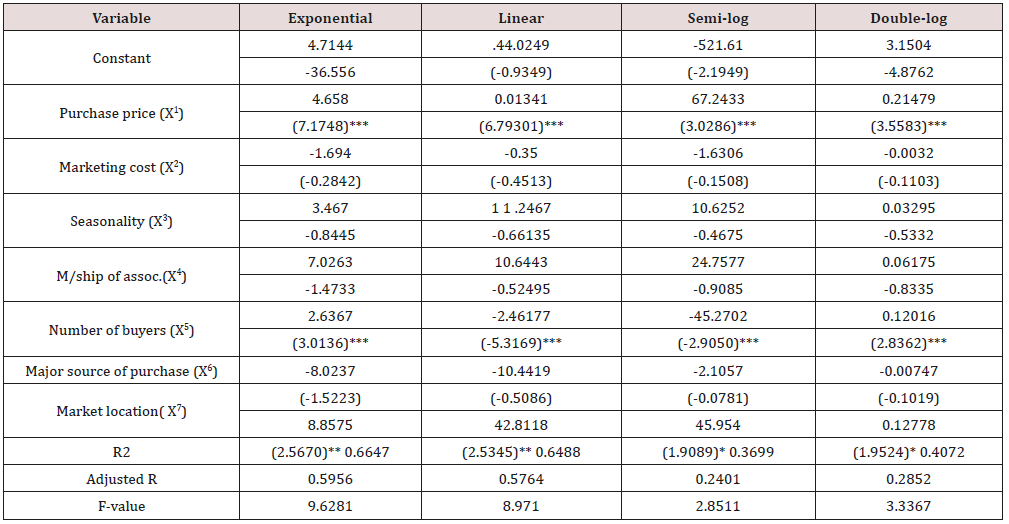
***Sig@ 1%; **sig@ 5%, *sig@ 10%, + Lead equation. Source: Computed Results 2019
This implies that 77.37% variability in selling price was explained by the variables considered in the model, while the remaining 22.63% was unexplained which could be attributed to errors and omitted variables. The F-statistics value of 5.8594 was significant which implies that the model is the best fit for the expression and an indication of overall significance of the regression. Out of the seven independent variables, three variables namely purchase price (X1), marketing cost (X2) and seasonality (X3) were statistically significant at 5% level of probability. The regression result of the factors influencing the retailer's selling price for beans in the Table 3 above shows the four functional forms, and based on the values of R~, F-statistics and the a priori expectation, the exponential function was chosen as the lead equation as it has the highest significant R2 as indicated by F-statistics (9.6281). Results show that the coefficient of multiple determinations (R~) was 0.6647.This implies that 68.78% of the variability in retailer's selling price was explained by the exogenous variables included in the model while the remaining 33.53% was unexplained variables attributed to omitted variables captured by the error term. The F-statistics value of 5.8594 (p<0.00) was significant implied the model is best fit for the expression and an indication of overall significance of the regression. Results show that the purchase price (X1), number of buyers (X4) and market location (7) were statistically significant at 5% respectively. This implies that purchase price, number of buyers and market location significantly affects the retailers selling price of beans.
Table 3: Factors influencing Retailers selling price of beans.
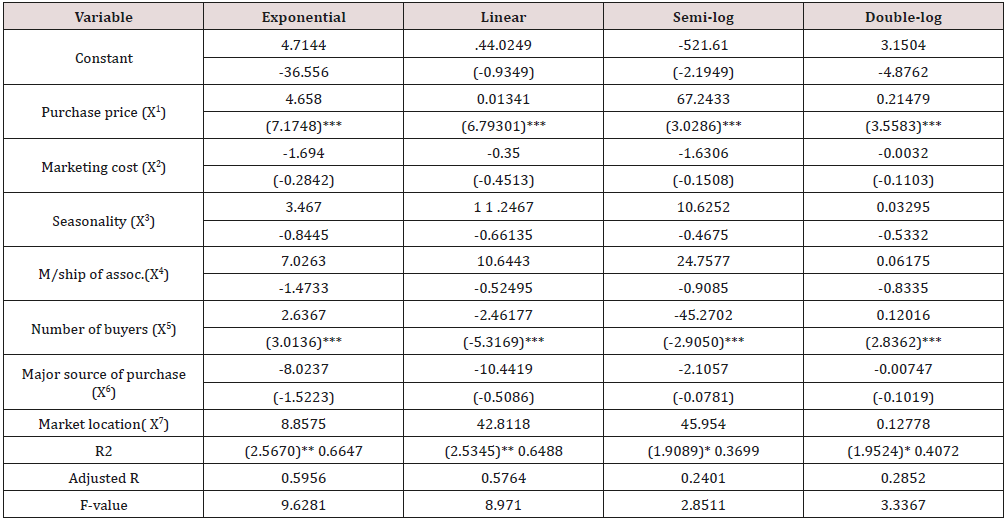
***sig at 1%; ** sig at 5%, * sig at 10% + Lead Equation Source: Computed Results, 2019
Factors Influencing the Marketing Margins for Beans
Table 4 shows the regression result of the factors influencing the wholesaler's marketing margins for beans in the study area. It shows the four functional forms, and based on the values of R~, l: -statistics and the a priori expectation, the double log function was chosen as the lead equation. Results showed that the coefficient of multiple determinations (R~) was 0.7441. This implies that 74.41% of the variability in wholesaler's marketing margins was explained by the independent variables included in the regression model, while the remaining 25.59% was unexplained due to omitted variables in the model as captured by the errors term of the regression model. The F-statistics value of 2.6166 (p<0.01) was significant implied the model is best fit for the expression and an indication of overall significance of the regression. Results show that the purchase price (X1), transportation cost (X3), handling cost (X5) and seasonality (X10) were statistically significant at 5% which implies that the marketing margin of the beans marketers are greatly influenced by the impact of purchase price, transportation cost, handling cost and seasonality nature of beans. The above results in Table 5 shows the regression result of the factors influencing the retailer's marketing margins for beans in the study area. It shows the four functional forms and based on the values of R and F-statistics the linear function was chosen as the lead equation. Results showed that the coefficient of multiple determinations (R) was 0.8401.
Table 4: Shows factors that influence wholesalers marketing margin.
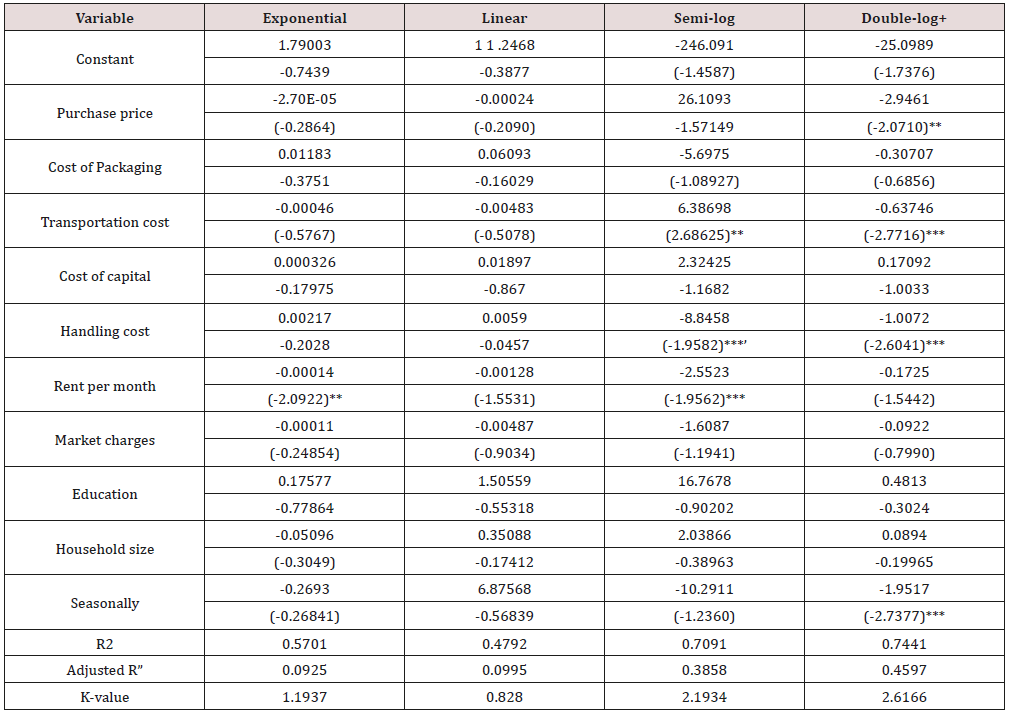
*** Significant at 1%; ** significant at 5%, ^significant at 10% + Lead equation Source: Computed Results, 2019.
Table 5: Factors Influencing the Retailers Marketing Margin.
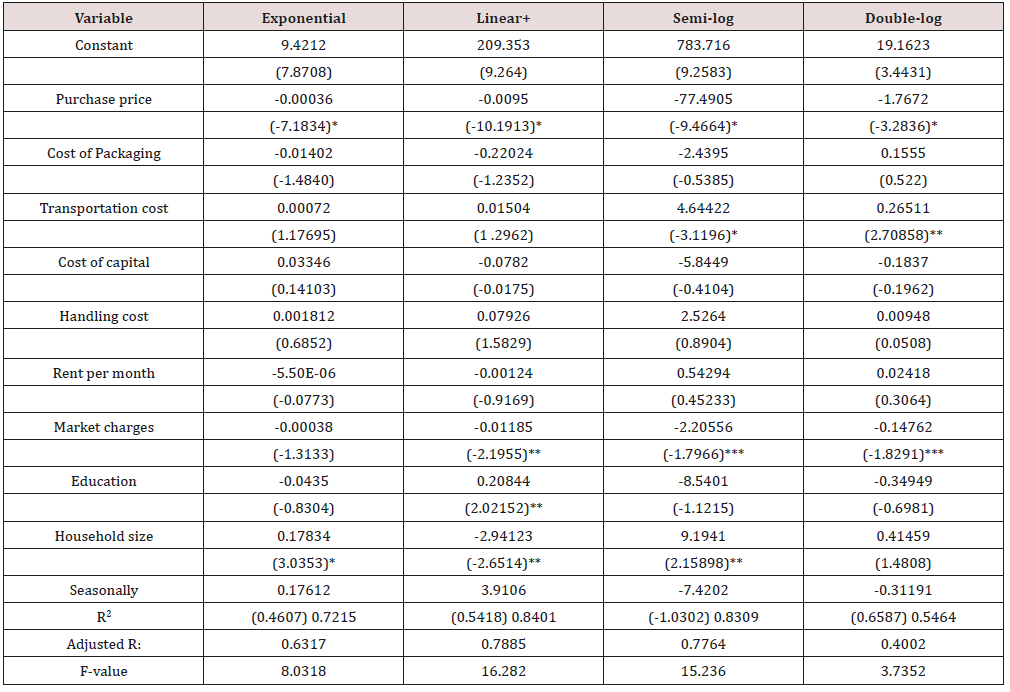
***significant at 1%; ** significant at 5%, *significant at 10% + = Lead equation Source: Computed Results, 2019.
Results of the Factor Influencing Retailer’s Marketing Margins for Beans
This implies that 84.01% of the variability in retailer's marketing margins was explained by the included variables in the model, while the remaining 15.99% was unexplained and could be attributed to omitted variables in the regression which are captured as error term. The F-statistics value of 1.6282 (p<0.00) was significant implied the model is best fit for the expression and an indication of overall significance of the regression results show that the (X1), (X7), (X8) and (X9) were significant at 5% which means that purchase price, market charges, level of education and household size have tremendous impact on the retailers marketing margins. Results in Table 6, indicates that the insurgencies in the northern part of country, high transportation cost to and from the major purchase sources and high purchase price are the constraints militating against efficient marketing of beans in the area. The high prices of beans may be due the unrest experienced from point of production. High price could equally be as resulting in low yields and consequently scarcity. NPC [15] linked the high prices to the sale of beans to urban markets thus decreasing supply in source markets, and hence results in high prices. Abate also confirmed that prices for beans are generally higher in a season especially in the months between January and April [16,17].
Table 6: Factors Influencing the Retailers Marketing Margin.
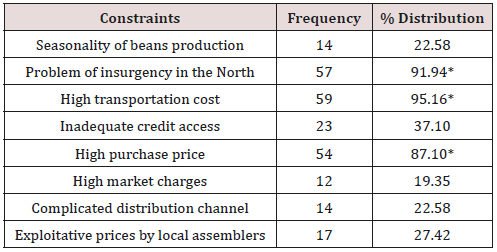
*Major constraints. Source: Field Survey Data, 2019.
Conclusion
The study shows that the beans marketers were mostly men with majority on wholesaling than in retailing, still in their youthful age and are energetic to carry out their marketing activities efficiently. Purchase price of beans favored the selling price of wholesalers and retail marketing however; it is a major disincentive to their marketing margins and marketing costs particularly during bumper period when the selling price is lower than purchase price. Seasonality of beans has a negative effect on wholesalers selling price and marketing margins during harvest periods when sellers’ price is at the lowest and distinctive to wholesale marketing. High marketing charges and handling costs have negative impact on the marketing margins on both traders. Problem of insurgencies from the north is the major constraint faced by beans marketers in the study area.
References
- Ayanwuyi E, Akintonde JO (2013) Effect of climate change on cowpea production in Kuje council, Abuja, Nigeria.
- Ayinde IA, AO Adejobi (2002) Marketing Institutions for Cowpea in Maiduguri and Abeokuta, Investigations on Building a Food Marketing Policy in Nigeria.
- Singh BB, MJ Mortimore, F Harris, SF Blade (1997) Cowpea in Traditional Cropping System. In: BB Singh, DR. Mohan Raj, KE Dashiell and LEN Jackai (Eds.), Advances in Cowpea Research. Copublication of IITA/JIRCAS, IITA, Ibadan, Nigeria, pp. 99-113.
- Gieri AA, Salihu M, Salamatu U (2015) Determination of Conduct, Performance and Structure of Cowpea Marketing in Yola North and South Local Government Areas of Adamawa State, Nigeria. American Research Journal of Agriculture 1(2): 23-31.
- Futuless K N, Bake I D, Tizhe W (2010) Effect of Sowing Date on Yield and Yield Components of Cowpea (Vigna unguiculata (l.) walp) in Mubi North Local Government Area, Adamawa State, Nigeria. New York Science Journal 3(11): 98-102.
- Food and agriculture organization statistical database, FAOSTAT. (2013) FAOSTAT. Statistical Database of Food and Agriculture Organization of the United Nations, Rome, Italy.
- Nathan Simon, Moses JD, Jimjel Zalkuwi, Altine J Medugu (2015) Profitability Analsis of Cowpea Production in Gombi Local Government Area of Adamawa State. International Journal of Advances in Agricultural Science and Technology 2(11): 1-8.
- Usman Shaba Mohammed, FatunaKilani Mohammed (2014) Profitability Analysis of cowpea production in rural area of Zaria local government Of Kaduna State Nigeria. International journal of Development and Sustainability 3(9): 1919-1926.
- (2012) African Agricultural Technology Foundation (AATF) Baseline Study for Impact Assessment of High Insect Resistant Cowpea in West Africa. Nairobi, kenya.
- Government (2006). Ministry of Information, Lafia annual report.
- Modu Y, Putai AJ, Petu Ibikunle AM (2010) An Economic Analysis of Cowpea Production among Women Farmers in Askira-Uba Local Government Area of Borno State, Nigeria. African Journal of General Agriculture. 6(1): 7-17.
- Bakoji I (2014) Economic Analysis of Maize-Cowpea Intercrops in Akko Local Government Area, Gombe State, Nigeria. Journal of the Bangladesh Association of Young Researchers (JBAYR): 2.
- Enete AA, Okum UE (2010). Economics of water leaf production, Talinum Triangulare in Akwa Ibom state Nigeria Field action science Reports 4(1).
- Fasoranti OO (2008) Determinant of agricultural production and its profitability Akoko-land Ondo state, Nigeria. Journal of Social Science 4(1): 37-41.
- NPC (2006) National Population Commission 2006 Figure Nasarawa State.
- Mayaka VK (2013) An Assessment of Dry Beans Market Integration in Selected Markets in Kenya. A Thesis Submitted to the Graduate School in Partial Fulfillment of Requirements of the Award of Master of Science in Agricultural and Applied Economics (CMAAE) of Egerton University.
- Katanga Y N, Hussain I, Wudil A H, Haruna U (2016) Analysis of cowpea marketing channel in Kiyawa Local Government Area of Jigawa State, Nigeria. International Journal of Agricultural Policy and Research 4(9): 157-201.

Top Editors
-

Mark E Smith
Bio chemistry
University of Texas Medical Branch, USA -

Lawrence A Presley
Department of Criminal Justice
Liberty University, USA -

Thomas W Miller
Department of Psychiatry
University of Kentucky, USA -

Gjumrakch Aliev
Department of Medicine
Gally International Biomedical Research & Consulting LLC, USA -

Christopher Bryant
Department of Urbanisation and Agricultural
Montreal university, USA -

Robert William Frare
Oral & Maxillofacial Pathology
New York University, USA -

Rudolph Modesto Navari
Gastroenterology and Hepatology
University of Alabama, UK -

Andrew Hague
Department of Medicine
Universities of Bradford, UK -

George Gregory Buttigieg
Maltese College of Obstetrics and Gynaecology, Europe -

Chen-Hsiung Yeh
Oncology
Circulogene Theranostics, England -
.png)
Emilio Bucio-Carrillo
Radiation Chemistry
National University of Mexico, USA -
.jpg)
Casey J Grenier
Analytical Chemistry
Wentworth Institute of Technology, USA -
Hany Atalah
Minimally Invasive Surgery
Mercer University school of Medicine, USA -

Abu-Hussein Muhamad
Pediatric Dentistry
University of Athens , Greece

The annual scholar awards from Lupine Publishers honor a selected number Read More...




